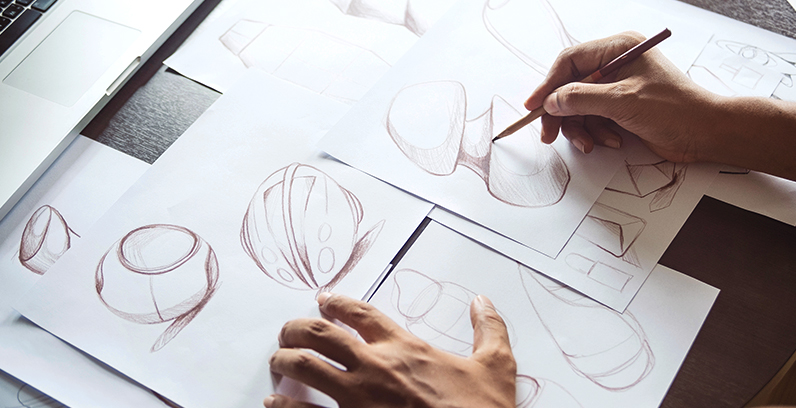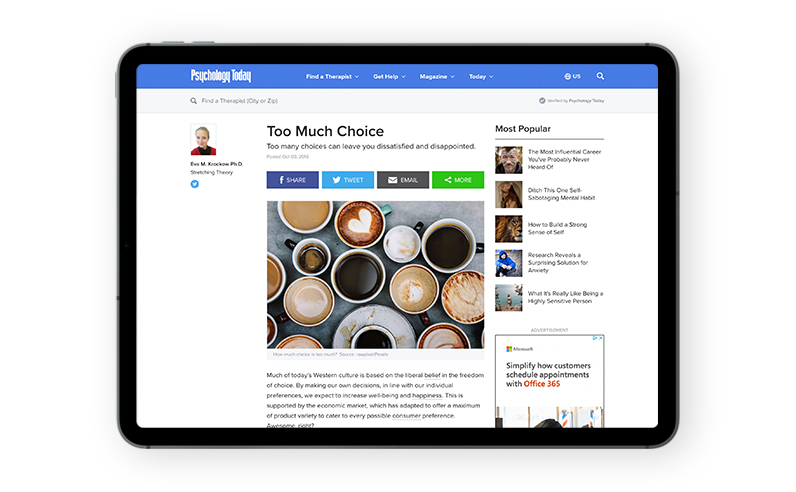Tangents
The Product Design Process and Presenting Initial Concepts: When Less is More
by Joe Schappler

[wtr-time]
Sometimes, when working in the early stages of the product design process AND you’re under deadline, you might feel that one of the ways to speed up the process is to come up with—and pitch—as many product concepts as you can.
But showing all of your approaches to internal decision makers may actually hurt your project’s progress.
How?
I’m going to briefly look at the psychology of choice, and then walk through an overview of a scenario from quite a few years back that I believe will help you when deciding how many concepts you should present in the early stages of new product design.
The Paradox of Choice
Offering someone more choices seems like it would be a benefit. For example, Starbucks claims to offer 80,000 different drink possibilities. But is that REALLY a benefit?
According to Psychology Today, “Research shows that if you’re surrounded by an abundance of options, you typically end up overwhelmed and less satisfied with your final decision than if you’d been given fewer options in the first place.”
The article goes on to outline that—especially when under time pressure—more choice makes it harder to choose, and take up more time—and you end up being less satisfied with your choice at the end. Decision-making is hard and having too many options makes that even harder.
Product Design for Medical Technology
Let’s look at an example of a situation we found ourselves a few years back.
A medical technology firm hired Helix to work on a new product design for them. We went through our process and developed several rough concepts (more high-level ideation—they like to see rough ideas first and then narrow it down).
So, we did about thirty product concepts, and sent all thirty over to their team. We asked them to tell us what they liked and didn’t like—thinking they’d love our ideas so much the project would continue quickly and smoothly.
In hindsight, this was a mistake (I’ll get more into that in a minute). While they really liked a lot of them, they got back to us and put the project on hold so they could figure out what to do next. Our intention was to give them choice—but we ended up creating a problem that didn’t need to be there by giving them too many options, which took more time to sort out.
I think we confused them by giving them so many different directions.
Presenting Your Product Design Concepts
Typically, we don’t give our clients this many rough ideas. It’s just too much for them to digest—or typical paralysis of choice. Generally speaking, our approach is to narrow our ideas internally down to around five and then share those with the client. It is our job, using our design expertise, to narrow the choices. This gives us the chance to communicate the different features; here’s this and that, with more of an explanation for the reasons behind our design decisions.
Unfortunately, many industrial design firms will put out a million ideas and think that has value to the client. But I don’t think it does. I think it adds confusion, takes up too much time and causes more mental heavy lifting on the part of the client.
Some firms believe that if you give many options it’s great for them—they believe that quantity equals value.
For example, they believe that if I give you five of something that’s great, if I give you 20 that’s awesome, and if I give you a hundred? Wow!
But quantity is not quality, and it’s certainly not indicative of value. In our business, there’s more work needed in the upfront stage beyond just ideation.
Somebody needs to be in the position on our side of the table to go through and vet the concepts, maybe developing prototypes, and saying “this is worth putting in front of the client and presenting as a solution”.
But sometimes things happen. In this case, the client was on an accelerated schedule. Things needed to move along quickly and we delivered those 30 product concepts to them in a week. They were ecstatic how quickly we turned it around—but then they put the project on hold. So what we thought was a benefit (a lot of concepts in a short amount of time) ended up actually negatively impacting the project.
They don’t really want the project on hold because they have a shipping deadline, but they don’t want to make the wrong decision. So we held them up by not doing what we know today is the best process.
The Right Way to Handle It
Over the years we’ve refined our process.
Today, we keep our initial concepts internal, then have an internal design review, narrow down features we like and those we don’t, we establish the pros and cons of each concept and narrow them down to maybe five rough concepts that we’ll share with the client.
And each of those five would have something distinctive about it that they’ll like or dislike, and want to move forward with or discard.
It gives the client action items based on elements we’ve already filtered out. And from that we refine our ideas down to two or three concepts that they then can make a decision to go to production with.
So, after 20+ years of designing products, that’s how we do it, and it works very well.
In my experience, skipping key steps like this can often backfire. Instead of saving time, it ends up costing time.
When Design Goes Bad
Sometimes designs are just intended to be bad designs, as conceived by Jacques Carelman. See the following link for some insight, and an infographic, into the beauty of bad product design. Humorous and enlightening. humorous bad product design infographic
Some Final Thoughts.
You should really avoid showing designs that you don’t love. We’ve had that happen in the past. Our typical practice is we will interview the clients to gather the information we need to begin the development process.
And finally, if you’re working on your latest product design or redesign project, and would like an extra set of eyes when planning, or want to bounce some ideas off a team that has the experience to provide value, please reach out directly to me via chat, or contact us today.
About Helix Design
Helix Design is an industrial design firm and product design company that delivers creative design and mechanical engineering solutions to companies who need external perspectives combined with practical experience. For samples of our recent work, please visit our industrial design portfolio.
Do you need industrial design guidance for your next project?
Contact us for an assessment today.


